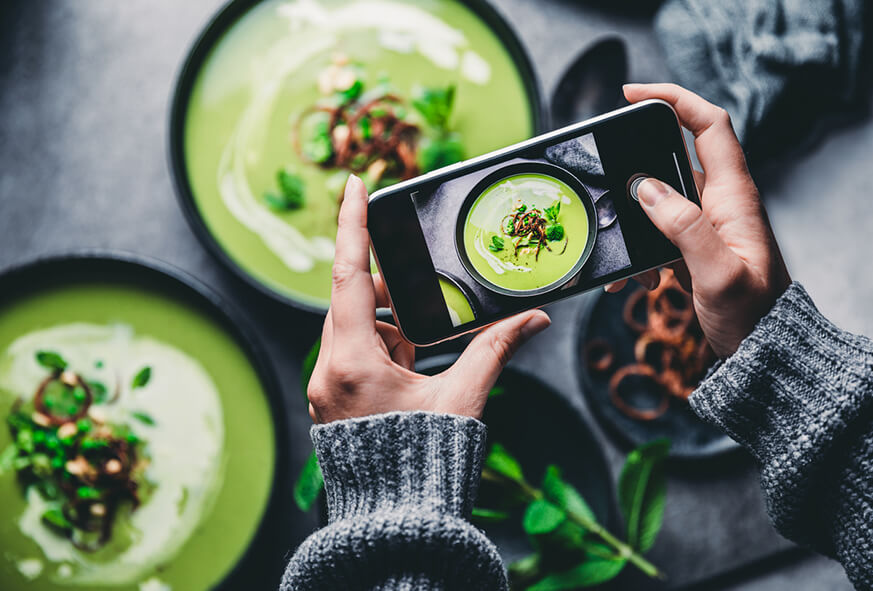In a world where a single scroll through social media can transport you to a realm of tantalizing dishes and culinary creations, the art of capturing these moments has emerged as a captivating form of visual storytelling. It’s the symphony of flavors and textures, expertly composed and illuminated, that leaps from the screen and beckons you to take a bite—through your eyes.
Welcome to a journey into the world of culinary imaging. In this guide, we’ll unlock the secrets to transforming your kitchen creations into mouth watering masterpieces, ready to dazzle your followers and elevate your gastronomic chronicles on social media.
Setting the Stage – Food Styling for Photography
1.1 Choose Your Canvas: Backgrounds and Surfaces
Imagine your plate as a blank canvas waiting to be painted with flavors and textures. The first step in capturing a perfect food shot is selecting the right background or surface. Wood, marble, slate, or even rustic old tables can add character to your photos. Experiment with various textures and colors to complement your dish.
1.2 Props Matter: Selecting Food Photography Props
Food photography props are the unsung heroes of your shots. Whether it’s vintage cutlery, colorful napkins, or fresh herbs, they can enhance the story your photo tells. Pay attention to details and ensure your props complement your dish rather than overpowering it.
Mastering the Art – Food Photography Techniques
2.1 Find Your Angle
The angle from which you shoot your food can make a world of difference. Play around with different angles such as overhead, 45-degree, or eye level shots to find the one that highlights your dish’s best features. Each angle can convey a unique mood and perspective.
2.2 Lighting Magic: Natural Light Food Photography
When it comes to food photography, lighting is everything. Natural light is your best friend, providing a soft, flattering glow that enhances the colors and textures of your food. Shoot near a window or outdoors during the golden hours for the best results.
The Tools of the Trade – Food Photography Equipment
3.1 Camera and Lens Selection
While a smartphone can produce stunning food photos, investing in a DSLR or mirrorless camera with a good lens can take your shots to the next level. Experiment with prime lenses for beautiful bokeh effects and sharper details.
3.2 Best Camera Settings for Food Photography
Understanding your camera settings is crucial. Set a wide aperture (low f-stop) for that creamy background blur, adjust your ISO to control brightness, and experiment with shutter speed to capture motion or stillness as per your vision.
Polishing Your Masterpiece – Editing Food Photos for Instagram
4.1 Food Photography Composition
Before you even think about post-processing, nail your composition. Use the rule of thirds, leading lines, and framing to create visually pleasing arrangements. Consider the balance between negative space and the main subject for an aesthetic touch.
4.2 Food Photography Editing Apps and Filters
Editing your photos is the final step in crafting an Instagram-worthy masterpiece. Apps like Adobe Lightroom, VSCO, and Snapseed offer a range of tools to enhance colors, adjust exposure, and add that extra pop to your shots. Experiment with filters to create a consistent aesthetic for your Instagram feed.
Bonus Tips and Tricks: Elevating Your Food Photography Game
– Food Photography Trends and Inspiration
Stay updated with the latest food photography trends. Explore Instagram and Pinterest for inspiration from talented photographers. Don’t be afraid to think outside the box and put your unique twist on popular styles.
– Food Photography Ideas and Hacks
Experiment with different dishes, cuisines, and plating styles. Try shooting during different times of the day to capture various lighting conditions. Invest in a tripod for steady shots and use a reflector to bounce light onto your subject for added dimension.
In conclusion, food photography is a delightful blend of creativity, technique, and storytelling. With these tips, you can embark on a delicious journey to capture the perfect Instagram-worthy shots that will leave your audience craving for more. Remember, practice makes perfect, so keep experimenting and refining your skills.

